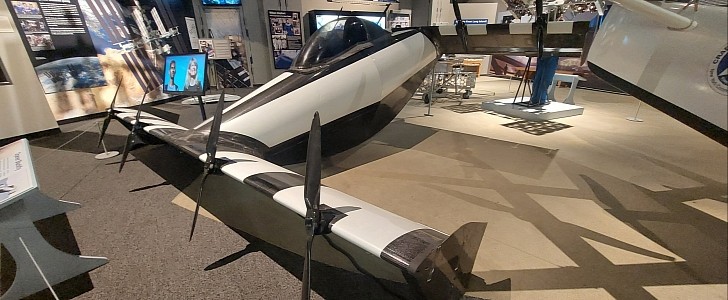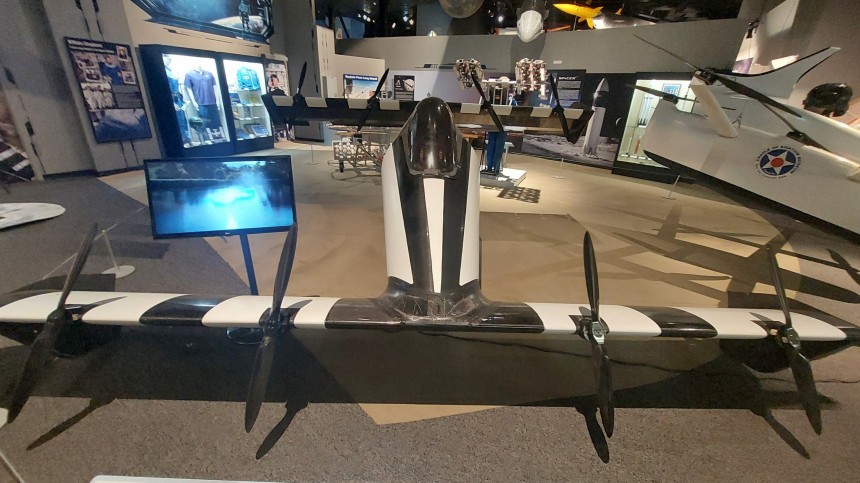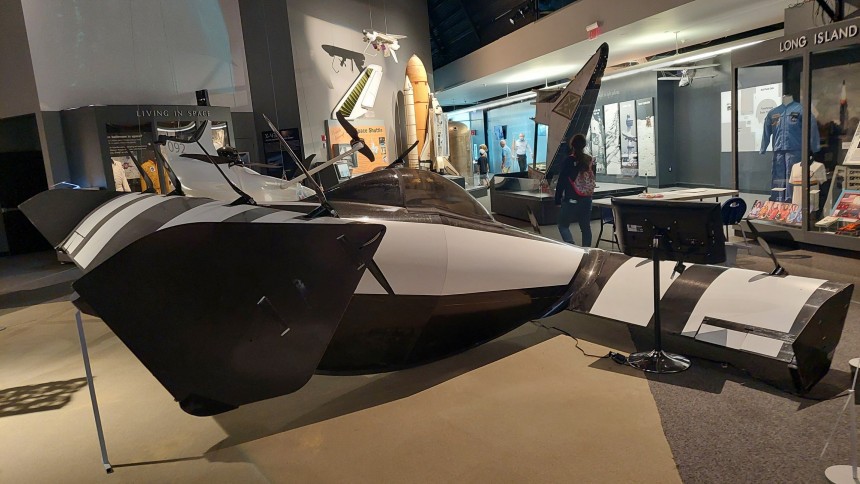If you know about the Opener Blackfly, it's probably because you saw CBS correspondent John Blackstone take one for a spin and miraculously not wrap it around a tree or some other form of hijinks. But thanks to the particular vehicle he was piloting, that was never going to happen.
The Opener Blackfly is one of the first legitimate attempts at bringing a mass-produced eVTOL personal transportation vehicle to the market in any significant capacity. No wonder this example sits among a host of other eVTOL concepts at the Cradle of Aviation in Garden City, New York. On the former site where Charles Lindbergh took off bound for Paris, these eVTOLs may not have the same ambitions. But it can't be argued; they're still cool as heck.
Founded in Ontario, Canada, by Mr. Marcus Leng and now based in Palo Alto, California, their single product, the Blackfly, is an engineering marvel. It allows a single pilot without passengers to take off in the same manner as a helicopter, fly as the crow flies as far as 25 miles at speeds exceeding 60mph (96.5 kph). With an inner structure composed of epoxy-bonded carbon fiber, an empty weight of 343 lbs (155.6kg) doesn't sound unreasonable at all.
This surprisingly sparce weight also qualifies the airframe as an ultralight vehicle that requires no pilot's license to operate via FAA regulations. The craft consists of a single-seat cockpit attached to a long, tube-like fuselage with a set of straight wings at the aircraft's front and back. It can't exactly be called a biplane, but it sure is an airplane with two sets of wings, if that makes sense. At 13 feet and seven inches wide (4.12 m), 13 feet and five inches long (4.08 m), and five feet tall (1.52 m), the Blackfly is wider than even the widest Lamborghini Aventador.
Such a wide load may not bode well for storage inside parking or home garages, but something tells us an airplane hangar is a better storage facility for a vehicle like this. Powering the Opener Blackfly is a series of eight DC electric motor units charged by an 8 kWh battery in the U.S. and 12 kWh in international markets. Both will be paired to a series of eight dual-bladed composite propellers to cut through turbulent air with relative ease.
Using either a 120 or 240-volt power outlet at anywhere from 15 to 50 amps, the Balck fly can recharge from 20 to 100 percent in anywhere from seven hours to just over one hour. While FAA regulations prevent the Blackfly from reaching its top speed, international examples are slated to have top speeds as high as 80 mph (128.8 kph). Like lots of eVTOL projects, the Opener Blackfly is designed to take off from a wide array of terrains. That includes snow, grass, tarmac, gravel, and even ice.
With a clever fly-by-wire control system, no physical levers or metal cables operate the Blackfly's control surfaces. It's all controlled by a suite of sensors and electric actuators that make real-time adjustments based on the pilot's flight stick input. This system also allows for an advanced autoland system to bring the aircraft safely to the surface in both regular landings and emergencies.
Four redundant pairs of elevon controls ensure even in a said emergency, so there shouldn't be too much loss of control in a bind. If all else fails, Blackfly production models will all come sporting a ballistic parachute in the event of loss of power and control. But compared to other exhibits at the Cradle of Aviation's eVTOL display, is the Blackfly the most practical?
Unlike the Kitty Hawk Flyer located just to the right of the Blackfly, it had indeed been able to reach full-scale, non-test prototype production beginning in 2021, with retail sales slated to start in late 2022. Though no definitive pricing has been laid out just, the consensus seems to be that the Blackfly will cost around the same money as a high-end luxury SUV. So then, not exactly cheap, utilitarian eVTOL transportation for the masses.
But perhaps it's the Blackfly whose innovation finally lowers the price of entry to the eVTOL scene. If successful, it would almost assuredly usher in a new and profoundly exciting era of personal aviation. Check out our full coverage from the Cradle of Aviation Museum right here on autoevolution.
Founded in Ontario, Canada, by Mr. Marcus Leng and now based in Palo Alto, California, their single product, the Blackfly, is an engineering marvel. It allows a single pilot without passengers to take off in the same manner as a helicopter, fly as the crow flies as far as 25 miles at speeds exceeding 60mph (96.5 kph). With an inner structure composed of epoxy-bonded carbon fiber, an empty weight of 343 lbs (155.6kg) doesn't sound unreasonable at all.
This surprisingly sparce weight also qualifies the airframe as an ultralight vehicle that requires no pilot's license to operate via FAA regulations. The craft consists of a single-seat cockpit attached to a long, tube-like fuselage with a set of straight wings at the aircraft's front and back. It can't exactly be called a biplane, but it sure is an airplane with two sets of wings, if that makes sense. At 13 feet and seven inches wide (4.12 m), 13 feet and five inches long (4.08 m), and five feet tall (1.52 m), the Blackfly is wider than even the widest Lamborghini Aventador.
Such a wide load may not bode well for storage inside parking or home garages, but something tells us an airplane hangar is a better storage facility for a vehicle like this. Powering the Opener Blackfly is a series of eight DC electric motor units charged by an 8 kWh battery in the U.S. and 12 kWh in international markets. Both will be paired to a series of eight dual-bladed composite propellers to cut through turbulent air with relative ease.
With a clever fly-by-wire control system, no physical levers or metal cables operate the Blackfly's control surfaces. It's all controlled by a suite of sensors and electric actuators that make real-time adjustments based on the pilot's flight stick input. This system also allows for an advanced autoland system to bring the aircraft safely to the surface in both regular landings and emergencies.
Four redundant pairs of elevon controls ensure even in a said emergency, so there shouldn't be too much loss of control in a bind. If all else fails, Blackfly production models will all come sporting a ballistic parachute in the event of loss of power and control. But compared to other exhibits at the Cradle of Aviation's eVTOL display, is the Blackfly the most practical?
Unlike the Kitty Hawk Flyer located just to the right of the Blackfly, it had indeed been able to reach full-scale, non-test prototype production beginning in 2021, with retail sales slated to start in late 2022. Though no definitive pricing has been laid out just, the consensus seems to be that the Blackfly will cost around the same money as a high-end luxury SUV. So then, not exactly cheap, utilitarian eVTOL transportation for the masses.










